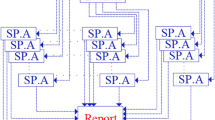Abstract
Benders Decomposition (BD) is a method used to solve stochastic linear problems via scenario analysis. Cluster BD (CBD) is one of its smart improvements that speed up the execution time, taking advantage of tighter feasible cuts found by grouping scenarios into clusters. In this paper, we propose a new design for CBD, one which takes into account the role played by optimal cuts in the solution. Besides, we propose a new parallel scheme for CBD to deal with large-scale two-stage stochastic linear problems. Moreover, we characterise the problems for which our proposal performs best. The results obtained show computational gains from our proposal compared with the plain use of CPLEX, serial BD, parallel BD, serial CBD and parallel CBD.






Similar content being viewed by others
References
Sinha, S.M.: Mathematical Programming: Theory and Methods. Elsevier, Berkeley (2005)
Solveling, G., Clarke, J.-P.: Scheduling of airport runway operations using stochastic branch and bound methods. Transp. Res. Part C 45, 137–199 (2014)
Burger, M., Graeber, B., Schindlmayr, G.: Stochastic Models for Electricity and Gas. Managing Energy Risk: A Practical Guide for Risk Management in Power, Gas and Other Energy Markets, Second Edition, 253–299 (2014)
Oliveira, F., Grossmann, I.E., Hamacher, S.: Accelerating benders stochastic decomposition for the optimization under uncertainty of the petroleum product supply chain. Comput. Oper. Res. 49, 47–58 (2014)
Wallace, S., Ziemba, W.T.: Applications of Stochastic Programming. Society for Industrial Mathematics, Philadelphia (2005)
Birge, J.R., Louveaux, F.V.: Introduction to Stochastic Programming, 2nd edn. Springer, New York (2011)
Watson, J.P., Woodruff, D.L.: Progressive hedging innovations for a class of stochastic mixed-integer resource allocation problems. Comput. Manag. Sci. 8(4), 355–370 (2011)
Kim, K., Zavala, V.M.: Algorithmic innovations and software for the dual decomposition method applied to stochastic mixed-integer programs. Math. Progr. Comput. 63, 1–42 (2017)
Escudero, L.F., Garín, M.A., Unzueta, A.: Cluster Lagrangean Decomposition in multistage stochastic optimization. Comput. Oper. Res. 67, 48–62 (2016)
Benders, J.: Partitioning procedures for solving mixed variables programming problems. Numer. Math. 4, 238–252 (1962)
Rahmaniani, R., Crainic, T.G., Gendreau, M., Rei, W.: The Benders Decomposition algorithm: a literature review. Eur. J. Oper. Res. 259(3), 801–817 (2017)
Van Slyke, R., Wets, R.J.-B.: L-shaped linear programs with applications to optimal control and stochastic programming. SIAM J. Appl. Math. 17, 638–663 (1969)
Wolf, C., Koberstein, K.: Dynamic sequencing and cut consolidation for the parallel hybrid-cut nested L-shaped method. Eur. J. Oper. Res. 230, 143–156 (2013)
Rahmaniani, R., Crainic, T., Gendreau, M., Rei, W.: A Benders Decomposition method for two-stage stochastic network design problems. CIRRELT, Centre interuniversitaire de recherche sur les réseaux d’entreprise, la logistique et le transport=Interuniversity Research Centre on Enterprise Networks, Logistics and Transportation (2017)
Aranburu, L., Escudero, L., Garin, A., Perez, G.: A so-called Cluster Benders Decomposition approach for solving two-stage stochastic linear problems. TOP 20, 279–295 (2012)
You, F., Grossman, I.E.: Multicut Benders Decomposition algorithm for process supply chain planning under uncertainty. Ann. Oper. Res. 210, 191–211 (2013)
Gurobi Optimization, LLC. Gurobi Optimizer Reference Manual. (2018). http://www.gurobi.com
IBM ILOG CPLEX V12.6. (2018). http://www-03.ibm.com/software/products/en/ibmilogcpleoptistud/
Acknowledgements
The Ministerio de Economía y Competitividad supported this work under contract TIN2017-84553-C2-2-R. Lluis M. Pla-Aragones wishes to acknowledge the financial support of the Spanish Research Program TRA2013-48180-C3-P. Some authors are members of the research group 2017-SGR363, funded by the Generalitat de Catalunya. Besides, this research is partly supported by the European Union FEDER (CAPAP-H6 network TIN2016-81840-REDT).
Author information
Authors and Affiliations
Corresponding author
Rights and permissions
About this article
Cite this article
Mateo, J., Plà, L.M., Solsona, F. et al. A scalable parallel implementation of the Cluster Benders Decomposition algorithm. Cluster Comput 22, 877–886 (2019). https://doi.org/10.1007/s10586-018-2878-4
Received:
Revised:
Accepted:
Published:
Issue Date:
DOI: https://doi.org/10.1007/s10586-018-2878-4




